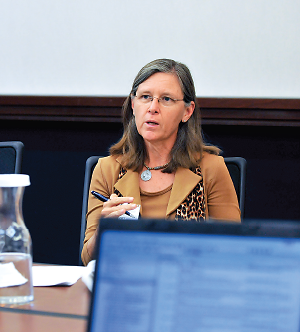Integrated or collaborative care may be one future for community psychiatry, but there may be more than one way to integrate care.
Lori Raney, M.D., of Dolores, Colo., advocates integrating psychiatry with primary care, just like many of her colleagues do. Working closely with a social worker and a psychologist, Raney offers psychiatric consultation and support to the primary care clinicians at a federally qualified health center in southwest Colorado. She described her program at last month’s APA Institute on Psychiatric Services.
Raney works in a five-county area, with a population of 125,000 people. She covers eight sites, including three school-based health centers.
Primary care clinicians with whom she works include family practice specialists, internists, pediatricians, and nurse practitioners. Mental health practitioners are mostly social workers, with a few Ph.D. psychologists. Raney calls herself an “adult-trained, child-willing” psychiatrist.
“We go out, find people with mental illness, put them in a registry, and then use the PHQ-9 to follow them,” she said. “Both the model and the treatment are evidence-based.”
The primary care and the mental health practitioners do most of the direct work with patients. Raney sees only 5 percent to 7 percent of the patients face to face. Most of her contacts are with the mental health practitioners, who maintain contact with the primary care clinicians. However, she tries to schedule a monthly on-site meeting to answer questions about diagnoses and psychopharmacology, but mainly to build relationships with the primary care clinicians.
“I tell them, ‘I’ve got your back,’ ” she said. “We psychiatrists have to be available—by cell phone, text, and e-mail—and mean what we say when we offer to help them manage medications.”
The system demands involvement by everyone, not just clinicians. The front-desk staff, for instance, can’t slack off in the screening that can alert the physicians about potential problems.
Using the registry helps the staff rank patients by severity, which then guides treatment.
“The psychiatrist needs to track and treat the sickest patients first, then take them off the list as they get better,” she said.
That’s the traditional model of integrated care: moving the psychiatrist into the primary care clinic. However, at the same time, Raney approaches care integration from the other direction. At the Cortez Integrated Health Center, she designed a facility for people with serious mental illness that also addresses their general medical needs.
“There’s one parking lot, one waiting room, one mission, one board, one checkout, one care plan that is comprehensive,” she pointed out.
In addition to “consultation and education” offices for psychiatric care, the facility also has rooms for basic physical exams. Patients are directed to a space based on their needs at that appointment.
The practice is not limited to severely mentally ill individuals, she said. “We’re open to everyone in the community for primary care,” starting with the families of the clinic’s psychiatric patients.
Every patient gets screened for risk factors such as cholesterol level, high blood pressure, diabetes, and smoking, as well as for psychiatric illnesses.
Even modest reduction in those conditions can reduce morbidity and mortality and perhaps extend the sharply reduced lifespan of people with severe mental illness.
The entire staff is trained to recognize the patient’s total health needs. To that end, they sometimes play what Raney calls, “the numbers game,” she said. She can walk into the clinic and call out “25” and the staff recognizes the reference to body mass index and the cutoff for “overweight,” to cite just one example.
There’s one final twist to her work at Cortez. Raney asks the primary care clinicians for consultations on general medical issues.
“This raises my comfort level and brings my skill level up,” she said. “Now I can have a real conversation with my colleagues. It makes me feel like a more-well-rounded physician.”


